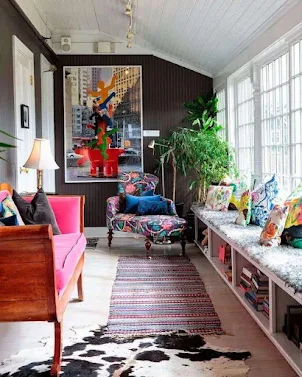Maximalism 2.0: The Return of "More" in Modern Home Décor

In the world of interior design, minimalism has had its day. For years, it ruled with its austere palettes, clean lines, and understated elegance. But, as with all things, a shift was inevitable. Enter: the resurgence of maximalism. However, this isn’t your grandmother’s maximalism of gaudy layers, overstuffed furniture, and clashing prints. Maximalism 2.0 is a new breed of “more is more” that embraces chaos, beauty, and abundance while reinterpreting the concept for today’s discerning eye.
Maximalism is making a loud, proud comeback. But what makes this new wave of maximalism different from its previous incarnations? Let’s dive into the evolution of this unapologetically bold trend, breaking down what has changed and how the modern maximalist ethos is shaking up home décor with a fresh perspective.
Yesterday’s Maximalism: The Good, The Bad, and The Kitschy
You’ll recall its intensity if you’ve seen maximalist interiors from past decades. It was a visual overload—riddled with clashing floral wallpapers, embroidered velvet, tapestry-like patterns, and heavily adorned surfaces. Maximalism was about wealth, grandeur, and status, with no restraint. It aimed to create environments where everything from the walls to the ceiling was dripping in opulence. Think of historic European homes, rococo flourishes, and a particularfondness for everything gilded. Maximalism in the 80s and 90s embraced the “more” philosophy by adding... more.
But while this original maximalism was often bold and expressive, it could also feel suffocating, kitschy, and outdated. The sheer chaos of the cluttered, over-decorated spaces was too much for modern sensibilities, and by the mid-2000s, minimalism swooped in to detoxify our eyes.
The Rise of Maximalism 2.0: A Revolution of Intent
Maximalism 2.0 isn’t about cramming as much into a room as possible. It’s about curated chaos—where every piece, though abundant, is intentionally placed. It is a new interpretation of abundance that balances boldness with refinement. What’s at the heart of this new maximalism is storytelling. Gone are the days of ostentatious displays of wealth through décor; today, it’s about creating layered spaces that reflect personality, travel, heritage, and lived experiences.
Here’s what has genuinely transformed:
1. Curated Collections vs. Hoarding
Modern maximalism is less about accumulation and more about curation. It borrows the “collector” mentality from the old maximalism but infuses it with thoughtfulness. That collection of eclectic objects now tells a story rather than coming across as a mishmash of whatever you could fit on the shelf. Whether it’s a collection of quirky pottery, vintage furniture, or a menagerie of eclectic art prints, Maximalism 2.0 celebrates personalization.
This new form embraces a fine-tuned eye for pieces with soul and sentimentality, allowing maximalists to blend new purchases with treasured heirlooms, creating a space that feels alive and evolving.
2. Clash of Colors, Reinvented
Color is still king in maximalism, but there’s more strategy at play. Where older versions of maximalism would throw every color onto the walls and hope for the best, modern maximalism has mastered the art of layering hues. Think jewel tones juxtaposed with soft pastels or bold contrasts like teal and mustard, grounded with muted earth tones. This maximalism invites experimentation without the eye strain.
Patterns, too, have become more nuanced. Stripes are paired with florals, but perhaps in more subtle colorways, giving a nod to harmony amidst the chaos. It’s daring but never unplanned.
3. Less Is... Still Not More, but It’s Thoughtful
Unlike the maximalism of yesteryears, Maximalism 2.0 isn’t synonymous with clutter. While it still encourages abundance and variety, it emphasizes negative space—where the eyes can rest between bold design moments. There’s an understanding that not every inch of a room needs to be filled, allowing for focal points to shine. That vintage couch doesn’t need to compete with five different tapestries and a gallery wall; it just needs one oversized piece of modern art to make a statement.
The restraint in modern maximalism is what makes it fresh. It avoids the sense of overwhelm by bringing balance to the visual feast.
4. Tech Integration Meets Maximalism
Old-school maximalism never had to contend with integrating tech into its aesthetic. But Maximalism 2.0 does so seamlessly. Whether a neon sign juxtaposed against antique furniture or a smart-home system incorporated into an ornate room, technology can coexist harmoniously with maximalism’s old-world charm. Hidden storage for gadgets, intelligent lighting systems that highlight accent pieces, and tech-forward art installations are finding their way into maximalist homes, blending form and function.
5. Maximalism with a Conscious Twist
Sustainability has become a key pillar in modern home décor, and Maximalism 2.0 is no exception. While older maximalism leaned heavily on new purchases and excess, modern maximalists opt for vintage, upcycled, and repurposed items. This new wave is less about consuming and more about reviving old pieces and giving them new life. It’s about decorating consciously while still indulging in the luxury of “more.” Flea market finds, and second-hand treasures are layered alongside contemporary designer pieces, creating a thoughtful juxtaposition of eras.
Maximalism’s Unlikely Zen: The Art of Expressive Living
Despite the abundance, there is a surprising sense of calm in Maximalism 2.0. It’s not just a design choice but a lifestyle. In an age of conformity, hyper-curated social media feeds, and minimalism-induced boredom, maximalism offers a creative rebellion—a way to embrace individuality, memories, and stories and express them through design.
Maximalism 2.0 is for the bold. It’s for those who refuse to be boxed into one aesthetic. It’s for those who believe their homes should reflect their lives—wild, eclectic, and unapologetically full.
Ultimately, the new maximalism is more than just décor; it’s a statement. It’s loud, it’s vivid, it’s nuanced—and it’s here to stay. Maximalism has always been about emotion, but Maximalism 2.0 takes it to the next level by combining intention, design, and soul, proving that more can be more... in the most beautiful way possible.







Comments
Post a Comment